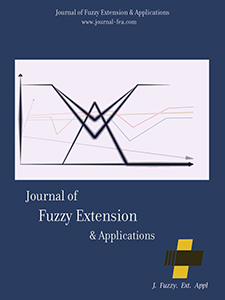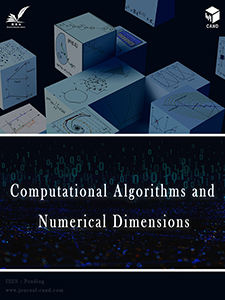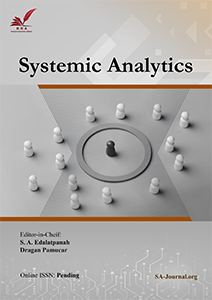Enhancing Shear Strength in Retrofitted Reinforced Concrete Beams with Fiber-Reinforced Polymers: An Artificial Neural Network Approach
Abstract
Fiber-Reinforced Polymers (FRP) have attracted much attention as a promising solution for preserving existing Reinforced Concrete (RC) buildings. Structures could be maintained by reinforcing, repairing, or retrofitting to address seismic inadequacies. For RC beams, shear failure is identified as the most catastrophic failure mode due to the lack of failure warning. However, there is not enough information on the shear behavior of these retrofitted beams, especially regarding the ideal design and placement of the FRP composites. This study aims to examine the shear strength of RC beams retrofitted with FRP composites and identifies the most efficient design and deployment procedures for these composites. The Artificial Neural Network (ANN) algorithm enhances the precision and efficiency of forecasting the shear strength, increases the solidity and durability of RC structures, and reduces the need for expensive repairs or replacements. Three RC beams were examined experimentally under combined torsion and shear. ANN values of RMSE = 0.466, R2 = 0.856, and r = 0.945 indicate a satisfactory correlation between experimental and numerical values and the AI model's reliability. The results of each training set are near 1 when considering the R2 values, regardless of torsion or shear exposure of the retrofitted T-beams. The test set R2 values of A1, A2, and AB under torsion and shear demonstrate correct ANN performance. Fiber reinforcement and the volumetric ratio of the FRP materials determine the final structural strength of RC beams enhanced with FRP. Higher torsional reinforced beams have a larger torsional capacity, final angle of twist, and enhanced post-cracking rigidity for a given twist angle.
References
[1] Kani, G. N. J. (1966). Basic facts concerning shear failure. ACI journal proceedings, 63, 675-692. DOI: 10.14359/7644
[2] ACI Committee. (2008). Building code requirements for structural concrete (ACI 318-08) and commentary. https://www.concrete.org/Portals/0/Files/PDF/Previews/318-08_preview.pdf
[3] Code, P. (2005). Eurocode 2: design of concrete structures-part 1--1: general rules and rules for buildings (Vol. 668). https://www.saiglobal.com/PDFTemp/Previews/OSH/IS/EN/2005/I.S.EN1992-1-1-2005.pdf
[4] Elsanadedy, H. M., Abbas, H., Al-Salloum, Y. A., & Almusallam, T. H. (2016). Shear strength prediction of HSC slender beams without web reinforcement. Materials and structures/materiaux et constructions, 49(9), 3749–3772. DOI:10.1617/s11527-015-0752-x
[5] Lee, J. Y., & Kim, U. Y. (2008). Effect of longitudinal tensile reinforcement ratio and shear span-depth ratio on minimum shear reinforcement in beams. ACI structural journal, 105(2), 134–144. DOI:10.14359/19728
[6] Syroka-Korol, E., & Tejchman, J. (2014). Experimental investigations of size effect in reinforced concrete beams failing by shear. Engineering structures, 58, 63–78. DOI:10.1016/j.engstruct.2013.10.012
[7] Lee, J. Y., Choi, I. J., & Kim, S. W. (2011). Shear behavior of reinforced concrete beams with high-strength stirrups. ACI structural journal, 108(5). https://www.researchgate.net/profile/Sang-Woo-Kim-6/publication/268031194_Shear_Behavior_of_Reinforced_Concrete_Beams_with_High-Strength_Stirrups/links/56a6caa708ae997e22ba4eec/Shear-Behavior-of-Reinforced-Concrete-Beams-with-High-Strength-Stirrups.pdf
[8] Shariati, M., Davoodnabi, S. M., Toghroli, A., Kong, Z., & Shariati, A. (2021). Hybridization of metaheuristic algorithms with adaptive neuro-fuzzy inference system to predict load-slip behavior of angle shear connectors at elevated temperatures. Composite structures, 278, 114524. DOI:10.1016/j.compstruct.2021.114524
[9] Davoodnabi, S. M., Mirhosseini, S. M., & Shariati, M. (2021). Analyzing shear strength of steel-concrete composite beam with angle connectors at elevated temperature using finite element method. Steel and composite structures, 40(6), 853–868. DOI:10.12989/scs.2021.40.6.853
[10] Nouri, K., Sulong, N. H. R., Ibrahim, Z., & Shariati, M. (2021). Behaviour of novel stiffened angle shear connectors at ambient and elevated temperatures. Advanced steel construction, 17(1), 28–38. DOI:10.18057/IJASC.2021.17.1.4
[11] Shariati, M., Mafipour, M. S., Mehrabi, P., Shariati, A., Toghroli, A., Trung, N. T., & Salih, M. N. A. (2021). A novel approach to predict shear strength of tilted angle connectors using artificial intelligence techniques. Engineering with computers, 37(3), 2089–2109. DOI:10.1007/s00366-019-00930-x
[12] Naghipour, M., Niak, K. M., Shariati, M., & Toghroli, A. (2020). Effect of progressive shear punch of a foundation on a reinforced concrete building behavior. Steel and composite structures, 35(2), 279–294. DOI:10.12989/scs.2020.35.2.279
[13] Shariati, M., Tahmasbi, F., Mehrabi, P., Bahadori, A., & Toghroli, A. (2020). Monotonic behavior of C and L shaped angle shear connectors within steel-concrete composite beams: An experimental investigation. Steel and composite structures, 35(2), 237–247. DOI:10.12989/scs.2020.35.2.237
[14] Davoodnabi, S. M., Mirhosseini, S. M., & Shariati, M. (2019). Behavior of steel-concrete composite beam using angle shear connectors at fire condition. Steel and composite structures, 30(2), 141–147. DOI:10.12989/scs.2019.30.2.141
[15] Mansouri, I., Shariati, M., Safa, M., Ibrahim, Z., Tahir, M. M., & Petković, D. (2020). Retraction note to: analysis of influential factors for predicting the shear strength of a V-shaped angle shear connector in composite beams using an adaptive neuro-fuzzy technique. Journal of intelligent manufacturing, 31(1), 267. DOI:10.1007/s10845-019-01493-w
[16] Hosseinpour, E., Baharom, S., Badaruzzaman, W. H. W., Shariati, M., & Jalali, A. (2018). Direct shear behavior of concrete filled hollow steel tube shear connector for slim-floor steel beams. Steel and composite structures, 26(4), 485–499. DOI:10.12989/scs.2018.26.4.485
[17] Paknahad, M., Shariati, M., Sedghi, Y., Bazzaz, M., & Khorami, M. (2018). Shear capacity equation for channel shear connectors in steel-concrete composite beams. Steel and composite structures, 28(4), 483–494. DOI:10.12989/scs.2018.28.4.483
[18] Khanouki, M. M. A., Ramli Sulong, N. H., Shariati, M., & Tahir, M. M. (2016). Investigation of through beam connection to concrete filled circular steel tube (CFCST) column. Journal of constructional steel research, 121, 144–162. DOI:10.1016/j.jcsr.2016.01.002
[19] Alam, M. S., & Hussein, A. (2013). Size effect on shear strength of FRP reinforced concrete beams without stirrups. Journal of composites for construction, 17(4), 507–516.
[20] Yost, J. R., Gross, S. P., & Dinehart, D. W. (2001). Shear strength of normal strength concrete beams reinforced with deformed GFRP bars. Journal of composites for construction, 5(4), 268–275.
[21] Razaqpur, A. G., Isgor, B. O., Greenaway, S., & Selley, A. (2004). Concrete contribution to the shear resistance of fiber reinforced polymer reinforced concrete members. Journal of composites for construction, 8(5), 452–460. DOI:10.1061/(asce)1090-0268(2004)8:5(452)
[22] Nehdi, M., El Chabib, H., & Saïd, A. A. (2007). Proposed shear design equations for FRP-Reinforced concrete beams based on genetic algorithms approach. Journal of materials in civil engineering, 19(12), 1033–1042. DOI:10.1061/(asce)0899-1561(2007)19:12(1033)
[23] ASCE-ACI Committee 445 on Shear and Torsion. (1998). Recent approaches to shear design of structural concrete. Journal of structural engineering, 124(12), 1375-1417.
[24] Park, R., & Paulay, T. (1991). Reinforced concrete structures. John Wiley & Sons.
[25] Mohammadhassani, M., Nezamabadi-pour, H., Suhatril, M., & Shariati, M. (2014). An evolutionary fuzzy modelling approach and comparison of different methods for shear strength prediction of high-strength concrete beams without stirrups. Smart structures and systems, 14(5), 785–809. DOI:10.12989/sss.2014.14.5.785
[26] Shariati, M. (2013). Behaviour of C-shaped shear connectors in stell concrete composite beams (Doctoral Dissertation, Jabatan Kejuruteraan Awam, Fakulti Kejuruteraan, Universiti Malaya). https://koreascience.kr/article/JAKO202117457480171.pdf
[27] Shariati, A., Sulong, N. H., Suhatril, M., & Shariati, M. (2012). Investigation of channel shear connectors for composite concrete and steel T-beam. International journal of the physical sciences, 7(11), 1828–1831.
[28] Shariati, M., Ramli Sulong, N. H., & Arabnejad Khanouki, M. M. (2010). Experimental and analytical study on channel shear connectors in light weight aggregate concrete. Proceedings of the 4th international conference on steel composite structures (pp. 21–23). Research Publishing Services.
[29] Shariati, M., Ramlisulong, N. H., Sinaei, H., Arabnejad Kh., M. M., & Shafigh, P. (2011). Behavior of channel shear connectors in normal and light weight aggregate concrete (experimental and analytical study). Advanced materials research, 168/170, 2303–2307. DOI:10.4028/www.scientific.net/AMR.168-170.2303
[30] Mohammadhassani, M., Nezamabadi-Pour, H., Suhatril, M., & Shariati, M. (2013). Identification of a suitable ANN architecture in predicting strain in tie section of concrete deep beams. Structural engineering and mechanics, 46(6), 853–868. DOI:10.12989/sem.2013.46.6.853
[31] Toghroli, A., Mohammadhassani, M., Suhatril, M., Shariati, M., & Ibrahim, Z. (2014). Prediction of shear capacity of channel shear connectors using the ANFIS model. Steel and composite structures, 17(5), 623–639. DOI:10.12989/scs.2014.17.5.623
[32] Kara, I. F. (2011). Prediction of shear strength of FRP-reinforced concrete beams without stirrups based on genetic programming. Advances in engineering software, 42(6), 295–304. DOI:10.1016/j.advengsoft.2011.02.002
[33] Bashir, R., & Ashour, A. (2012). Neural network modelling for shear strength of concrete members reinforced with FRP bars. Composites part B: engineering, 43(8), 3198–3207. DOI:10.1016/j.compositesb.2012.04.011
[34] Nasrollahzadeh, K., & Basiri, M. M. (2014). Prediction of shear strength of FRP reinforced concrete beams using fuzzy inference system. Expert systems with applications, 41(4/1), 1006–1020. DOI:10.1016/j.eswa.2013.07.045
[35] Lee, S., & Lee, C. (2014). Prediction of shear strength of FRP-reinforced concrete flexural members without stirrups using artificial neural networks. Engineering structures, 61, 99–112. DOI:10.1016/j.engstruct.2014.01.001
[36] Golafshani, E. M., & Ashour, A. (2016). A feasibility study of BBP for predicting shear capacity of FRP reinforced concrete beams without stirrups. Advances in engineering software, 97, 29–39. DOI:10.1016/j.advengsoft.2016.02.007
[37] Aiello, M. A., Ascione, L., Baratta, A., Bastianini, F., Battista, U., & Benedetti, A. (2014). Guide for the design and construction of externally bonded FRP systems for strengthening existing structures. https://hdl.handle.net/11311/883756
[38] Pansuk, W., & Sato, Y. (2007). Shear mechanism of reinforced concrete T-Beams with stirrups. Journal of advanced concrete technology, 5(3), 395–408. DOI:10.3151/jact.5.395
[39] Foster, R. M., Brindley, M., Lees, J. M., Ibell, T. J., Morley, C. T., Darby, A. P., & Evernden, M. C. (2017). Experimental investigation of reinforced concrete t-beams strengthened in shear with externally bonded CFRP sheets. Journal of composites for construction, 21(2), 4016086. DOI:10.1061/(asce)cc.1943-5614.0000743
[40] Ameli, M., Ronagh, H. R., & Dux, P. F. (2007). Behavior of FRP strengthened reinforced concrete beams under torsion. Journal of composites for construction, 11(2), 192–200.
[41] Chalioris, C. E. (2007). Tests and analysis of reinforced concrete beams under torsion retrofitted with FRP strips. WIT transactions on modelling and simulation, 46, 633–642. DOI:10.2495/CMEM070631
[42] Mohammadizadeh, M. R., & Fadaee, M. J. (2010). Experimental investigation on torsional strengthening of high-strength concrete beams using CFRP sheets. Kuwait journal of science and engineering, 37(1B), 1–19.
[43] Hii, A. K. Y., & Al-Mahaidi, R. (2006). Experimental investigation on torsional behavior of solid and box-section RC beams strengthened with CFRP using photogrammetry. Journal of composites for construction, 10(4), 321–329. DOI:10.1061/(asce)1090-0268(2006)10:4(321)
[44] Jing, M., Raongjant, W., & Li, Z. (2007). Torsional strengthening of reinforced concrete box beams using carbon fiber reinforced polymer. Composite structures, 78(2), 264–270. DOI:10.1016/j.compstruct.2005.10.017
[45] Chalioris, C. E. (2008). Torsional strengthening of rectangular and flanged beams using carbon fibre-reinforced-polymers - Experimental study. Construction and building materials, 22(1), 21–29. DOI:10.1016/j.conbuildmat.2006.09.003
[46] Deifalla, A., & Ghobarah, A. (2010). Strengthening RC T-Beams subjected to combined torsion and shear using FRP fabrics: experimental study. Journal of composites for construction, 14(3), 301–311. DOI:10.1061/(asce)cc.1943-5614.0000091
[47] Triantafillou, T., Matthys, S., Audenaert, K., Balázs, G., Blaschko, M., & Blontrock, H. (2001). Externally bonded FRP reinforcement for RC structures. International Federation for Structural Concrete.
[48] Hii, A. K. Y., & Al-Mahaidi, R. (2006). An experimental and numerical investigation on torsional strengthening of solid and box-section RC beams using CFRP laminates. Composite structures, 75(1–4), 213–221. DOI:10.1016/j.compstruct.2006.04.050
[49] Bernardo, L., & Taborda, C. (2020). Softened truss model for reinforced concrete beams under torsion combined with axial force. Applied mechanics, 1(1), 79–96. DOI:10.3390/applmech1010006
[50] Protchenko, K., & Szmigiera, E. (2020). Post-Fire characteristics of concrete beams reinforced with hybrid FRP bars. Materials, 13(5), 1248. DOI:10.3390/ma13051248
[51] Salih, R., Zhou, F., Abbas, N., & Mastoi, A. K. (2020). Experimental investigation of reinforced concrete beam with openings strengthened using frp sheets under cyclic load. Materials, 13(14), 3127. DOI:10.3390/ma13143127
[52] Pohoryles, D. A., Melo, J., & Rossetto, T. (2021). Combined flexural and shear strengthening of RC T-beams with frp and TRM: Experimental study and parametric finite element analyses. Buildings, 11(11), 520. DOI:10.3390/buildings11110520
[53] Abdolrasol, M. G. M., Suhail Hussain, S. M., Ustun, T. S., Sarker, M. R., Hannan, M. A., Mohamed, R., … Milad, A. (2021). Artificial neural networks based optimization techniques: A review. Electronics (Switzerland), 10(21), 2689. DOI:10.3390/electronics10212689
[54] Milad, A., Hussein, S. H., Khekan, A. R., Rashid, M., Al-Msari, H., & Tran, T. H. (2022). Development of ensemble machine learning approaches for designing fiber-reinforced polymer composite strain prediction model. Engineering with computers, 38(4), 3625–3637. DOI:10.1007/s00366-021-01398-4
[55] Amani, J., & Moeini, R. (2012). Prediction of shear strength of reinforced concrete beams using adaptive neuro-fuzzy inference system and artificial neural network. Scientia Iranica, 19(2), 242–248. DOI:10.1016/j.scient.2012.02.009
[56] Wang, J., Zou, X., & Feng, Y. (2015). Bilinear load-deflection model of fiber-reinforced polymer-concrete composite beam with interface slip. Advances in mechanical engineering, 7(7), 1–14. DOI:10.1177/1687814015590312
[57] ACI Committee 440. (2002). Guide for the design and construction of structural concrete reinforced with FRP Bars (Vol. 88). https://basalt-fibers.com/wp-content/uploads/2021/05/Standart_ACI-4401R15.pdf
[58] IStructE. (1999). Interim guidance on the design of reinforced concrete structures using fibre composite reinforcement. Institution of Structural Engineers. https://www.thenbs.com/PublicationIndex/documents/details?Pub=IStructE&DocId=247901
[59] Mufti, A. A., & ISIS Canada. (2001). Reinforcing concrete structures with fibre reinforced polymers. ISIS Canada.
[60] Recommendations, J. (2006). Japan society of civil engineers (JSCE): recommendations for design and construction of ultra-high strength fiber-reinforced conerete Structures. JSCE guidelines for concrete, (9). https://www.jsce.or.jp/committee/concrete/e/hpfrcc_JSCE.pdf
[61] Michaluk, C. R., Rizkalla, S. H., Tadros, G., & Benmokrane, B. (1998). Flexural behavior of one-way concrete slabs reinforced by fiber reinforced plastic reinforcements. ACI structural journal, 95(3), 353–365. DOI:10.14359/552
[62] Deitz, D. H., Harik, I. E., & Gesund, H. (1999). One-way slabs reinforced with glass fiber reinforced polymer reinforcing bars. Special Publication, 188, 279-286. DOI:10.14359/5629
[63] Tureyen, A. K., & Frosch, R. J. (2003). Concrete shear strength: Another perspective. Structural journal, 100(5), 609–615.
[64] El-Sayed, A. K., El-Salakawy, E. F., & Benmokrane, B. (2006). Shear strength of FRP-reinforced concrete beams without transverse reinforcement. ACI materials journal, 103(2), 235-243.
[65] Diamantis, Z. G., Efthimeros, G. A., Photeinos, D. I., Tsahalis, D. T., Networks, A. N., & Passenger, V. (2001). Development of an artificial neural network (ANN ) based virtual passenger. 4th European conference on noise control (pp. 14–17). EURONOISE.
[66] Del Vecchio, C., Di Ludovico, M., Balsamo, A., Prota, A., Manfredi, G., & Dolce, M. (2014). Experimental investigation of exterior RC beam-column joints retrofitted with FRP Systems. Journal of composites for construction, 18(4), 4014002. DOI:10.1061/(asce)cc.1943-5614.0000459
[67] Paulay, T., & Priestley, M. J. N. (1992). Seismic design of reinforced concrete and masonry buildings (Vol. 768). Wiley New York.
[68] Bousselham, A. (2010). State of research on seismic retrofit of RC beam-column joints with externally bonded FRP. Journal of composites for construction, 14(1), 49–61.
[69] Del Vecchio, C., Di Ludovico, M., Prota, A., & Manfredi, G. (2015). Analytical model and design approach for FRP strengthening of non-conforming RC corner beam-column joints. Engineering structures, 87, 8–20. DOI:10.1016/j.engstruct.2015.01.013

 Metrics
Metrics



